CITROEN DS3 CABRIO DAG 2016 Handbook (in English)
Manufacturer: CITROEN, Model Year: 2016, Model line: DS3 CABRIO DAG, Model: CITROEN DS3 CABRIO DAG 2016Pages: 458, PDF Size: 14.51 MB
Page 181 of 458
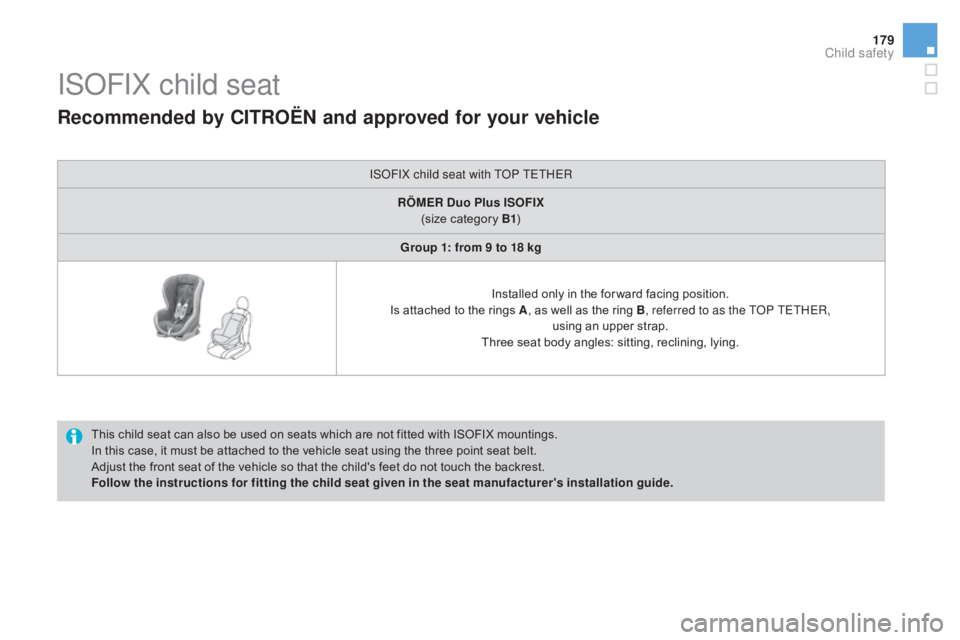
179
DS3_en_Chap07_securite-enfants_ed01-2015
ISOFIX child seat
This child seat can also be used on seats which are not fitted with ISOFIX mountings.
I n this case, it must be attached to the vehicle seat using the three point seat belt.
Adjust
the front seat of the vehicle so that the child's feet do not touch the backrest.
Follow the instructions for fitting the child seat given in the seat manufacturer's installation guide.
Recommended by CITROËn and approved for your vehicle
ISOFIX child seat with TOP TETHER
RÖMER
d
u
o Plus ISOFIX
(size
category B1)
gr
oup 1: from 9 to 18 kg Installed
only in the for ward facing position.
Is
attached to the rings A,
as well as the ring B, referred to as the TOP TETHER,
using
an upper strap.
Three
seat body angles: sitting, reclining, lying.
Child safety
Page 182 of 458

DS3_en_Chap07_securite-enfants_ed01-2015
Installing ISOFIX child seatsIn accordance with European regulations, this table indicates the options for the installation of ISOFIX child seats on the vehicle seats fitted with ISOFIX m ountings.
In
the case of the universal and semi-universal ISOFIX child seats, the child seat's ISOFIX size category, determined by a letter between A and g
, i
s
indicated
on the child seat next to the ISOFIX logo.
I UF:
s
eat suitable for the installation of an I sofix
Universal seat, F or ward
facing and secured using
t
he "TOP TETHER" upper strap.
IL- SU: seat suitable for the installation an I sofix
Semi- Universal
seat which is:
-
r
ear ward facing fitted with a "Top Tether" upper strap or a support leg,
-
f
or ward facing fitted with a support leg,
-
b
aby cot fitted with a "Top Tether" upper strap or a support leg.
For
the securing of the "Top Tether" upper strap, refer to the "ISOFIX Mountings" section.
X:
s
eat which is not suitable for the installation of an ISOFIX child seat or cot of the weight group
i
ndicated. Weight of the child and indicative age
Less than 10 kg (group 0)
Up
to 6 months
a
pproxLess than 10 kg
(group 0)
Less than 13 kg (group 0+)
Up
to 1 year approxFrom 9 to 18 kg (group 1)
From
1 to 3 years approx
Type of ISOFIX child seat Infant car seatrearward facing rearward facing forward facing
ISOFIX size categor y F
gCdE CdA BB1
U
niversal and semi-universal ISOFIX child
seats which can be installed on the outer
rear seats X
XIL- SU XIL- SU IUF
IL- SU
Remove
and stow the head restraint
b
efore installing a child seat with a
b
ackrest on a passenger seat. Refit the
h
ead restraint once the child seat has
been
removed.
Page 183 of 458

181
DS3_en_Chap07_securite-enfants_ed01-2015
Child safety
Page 184 of 458
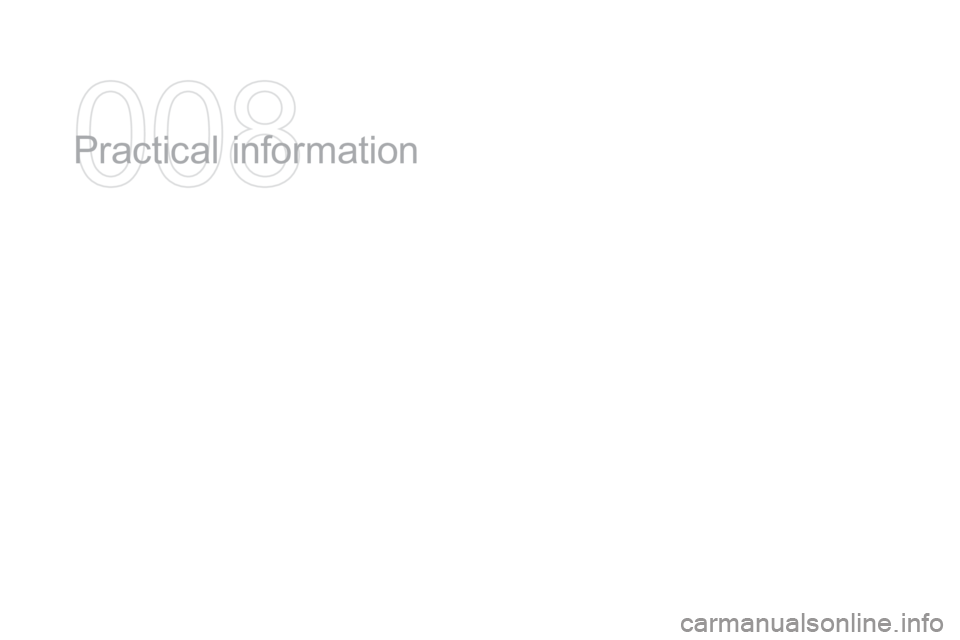
DS3_en_Chap08_info-pratiques_ed01-2015
Practical information
Page 185 of 458
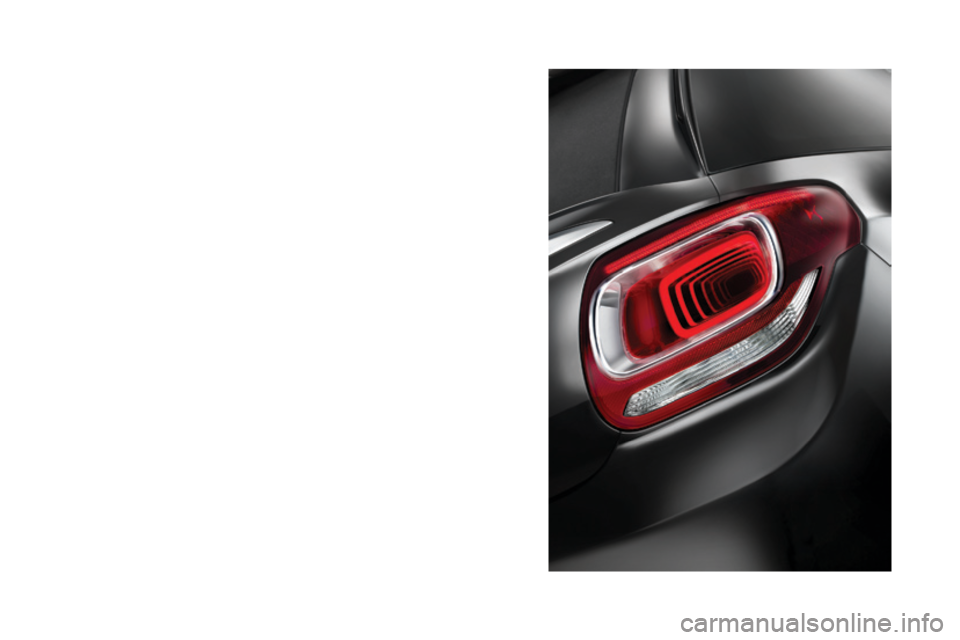
DS3_en_Chap08_info-pratiques_ed01-2015
Page 186 of 458
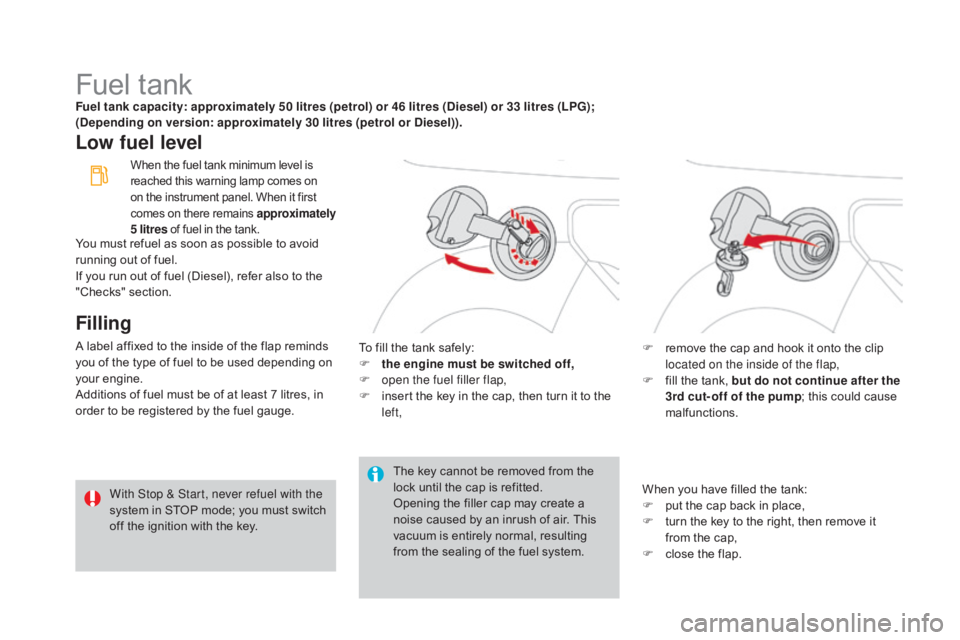
DS3_en_Chap08_info-pratiques_ed01-2015
Fuel tankFuel tank capacity: approximately 50 litres (petrol) or 46 litres (diesel) or 33 litres (LPg) ;
(dep ending on version: approximately 30 litres (petrol or di esel)).
Low fuel level
Filling
A label affixed to the inside of the flap reminds you of the type of fuel to be used depending on
y
our
eng
ine.
Additions
of fuel must be of at least 7 litres, in
o
rder to be registered by the fuel gauge.The
key cannot be removed from the
l
ock until the cap is refitted.
Opening
the filler cap may create a
n
oise caused by an inrush of air. This
v
acuum is entirely normal, resulting
f
rom the sealing of the fuel system.
To
fill the tank safely:
F
t
he engine must be switched off,
F
o
pen the fuel filler flap,
F
i
nsert the key in the cap, then turn it to the
l
eft,F
r emove the cap and hook it onto the clip
l
ocated on the inside of the flap,
F
f
ill the tank, but do not continue after the
3rd cut- off of the pump ;
this could cause
m
alfunctions.
When
you have filled the tank:
F
p
ut the cap back in place,
F
t
urn the key to the right, then remove it
f
rom the cap,
F
c
lose the flap.
When the fuel tank minimum level is reached this warning lamp comes on o
n the instrument panel. When it first
c
omes on there remains approximately
5 litres
of fuel in the tank.
With Stop & Start, never refuel with the
system in STOP mode; you must switch
o
ff the ignition with the key.
You
must refuel as soon as possible to avoid
r
unning out of fuel.
If
you
run out of fuel (Diesel), refer also to the
"
Checks"
s
ection.
Page 187 of 458
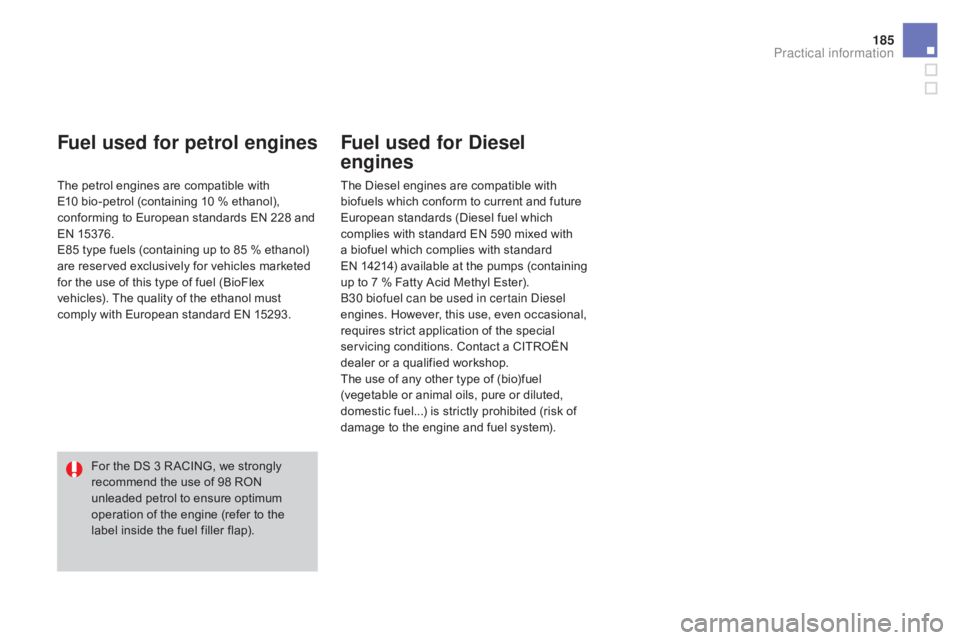
185
DS3_en_Chap08_info-pratiques_ed01-2015
Fuel used for petrol engines
The petrol engines are compatible with E10 bio-petrol (containing 10 % ethanol),
c
onforming to European standards EN 228 and
E
N
1
5376.
E85
type fuels (containing up to 85 % ethanol)
a
re reserved exclusively for vehicles marketed
f
or the use of this type of fuel (BioFlex
v
ehicles). The quality of the ethanol must
c
omply with European standard EN 15293.
Fuel used for diesel
engines
The Diesel engines are compatible with b
iofuels which conform to current and future
E
uropean standards (Diesel fuel which
c
omplies with standard EN 590 mixed with
a
biofuel which complies with standard
E
N 14214) available at the pumps (containing
u
p to 7 % Fatty Acid Methyl Ester).
B30 biofuel can be used in certain Diesel
engines.
However, this use, even occasional,
r
equires strict application of the special
s
ervicing conditions. Contact a CITROËN
d
ealer or a qualified workshop.
The
use of any other type of (bio)fuel
(
vegetable or animal oils, pure or diluted,
d
omestic fuel...) is strictly prohibited (risk of
d
amage to the engine and fuel system).
For
the
DS
3
R ACING,
we
strongly
r
ecommend
the
use
of
98
RON
u
nleaded
petrol
to
ensure
optimum
o
peration
of
the
engine
(refer
to
the
l
abel
inside
the
fuel
filler
flap).
Practical information
Page 188 of 458

DS3_en_Chap08_info-pratiques_ed01-2015
* According to country of sale.
Misfuel prevention (Diesel)*Mechanical device which prevents filling the tank of a Diesel vehicle with petrol. It avoids the risk of engine damage that can result from filling with the wrong fuel.
Located
in the filler neck, the misfuel prevention device appears when the filler cap is removed.
Operation
When a petrol filler nozzle is introduced into the
fuel filler neck of your Diesel vehicle, it comes
i
nto contact with the flap. The system remains
c
losed and prevents filling.
do n
ot persist but introduce a d
i
esel type
filler nozzle. It
remains possible to use a fuel can to
f
ill the tank.
In order to ensure a good flow of fuel,
d
o not place the nozzle of the fuel can
in direct contact with the flap of the
misfuel prevention device and pour
s
l ow l y.
Travelling abroad
As Diesel fuel pump nozzles may b
e different in other countries, the
presence
of the misfuel prevention
d
evice may make refuelling impossible.
Before
travelling abroad, we
r
ecommend that you check with the
C
ITROËN dealer network, whether
y
our vehicle is suitable for the fuel
pumps
in the country in which you want
t
o travel.
Page 189 of 458
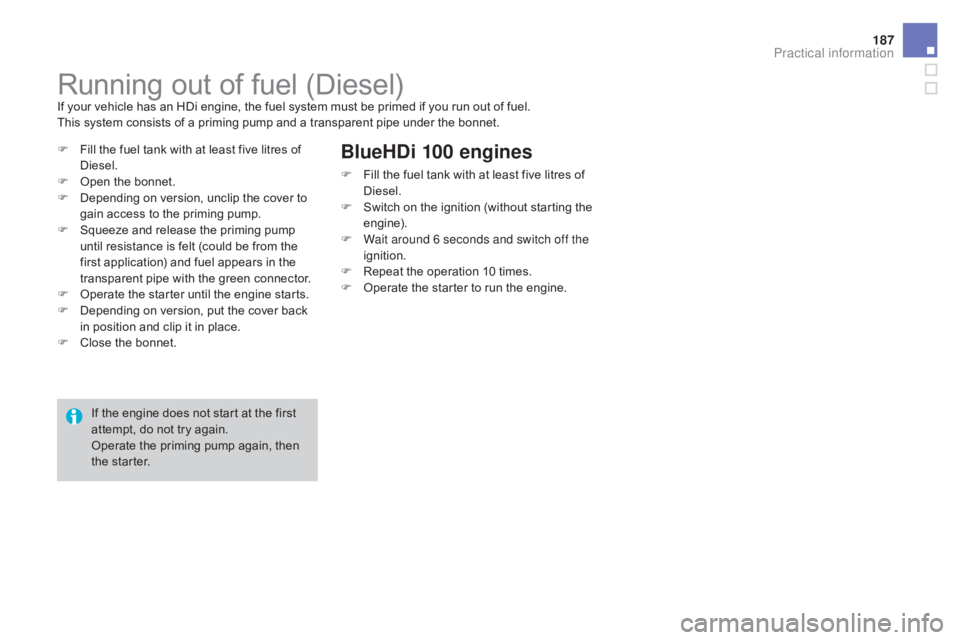
187
DS3_en_Chap08_info-pratiques_ed01-2015
Running out of fuel (Diesel)If your vehicle has an HDi engine, the fuel system must be primed if you run out of fuel.
T his system consists of a priming pump and a transparent pipe under the bonnet.
F
F
ill the fuel tank with at least five litres of
D
iesel.
F
O
pen the bonnet.
F
D
epending on version, unclip the cover to
g
ain access to the priming pump.
F
S
queeze and release the priming pump
u
ntil resistance is felt (could be from the
f
irst application) and fuel appears in the
t
ransparent pipe with the green connector.
F
O
perate the starter until the engine starts.
F
D
epending on version, put the cover back
i
n position and clip it in place.
F
C
lose the bonnet.
BlueHdi 100 engines
F Fill the fuel tank with at least five litres of D
iesel.
F
S
witch on the ignition (without starting the
e
ngine).
F
W
ait around 6 seconds and switch off the
ignition.
F
R
epeat the operation 10 times.
F
O
perate the starter to run the engine.
If
the
engine
does
not
start
at
the
first
a
ttempt,
do
not
try
again.
Operate
the
priming
pump
again,
then
t
he
starter.
Practical information
Page 190 of 458
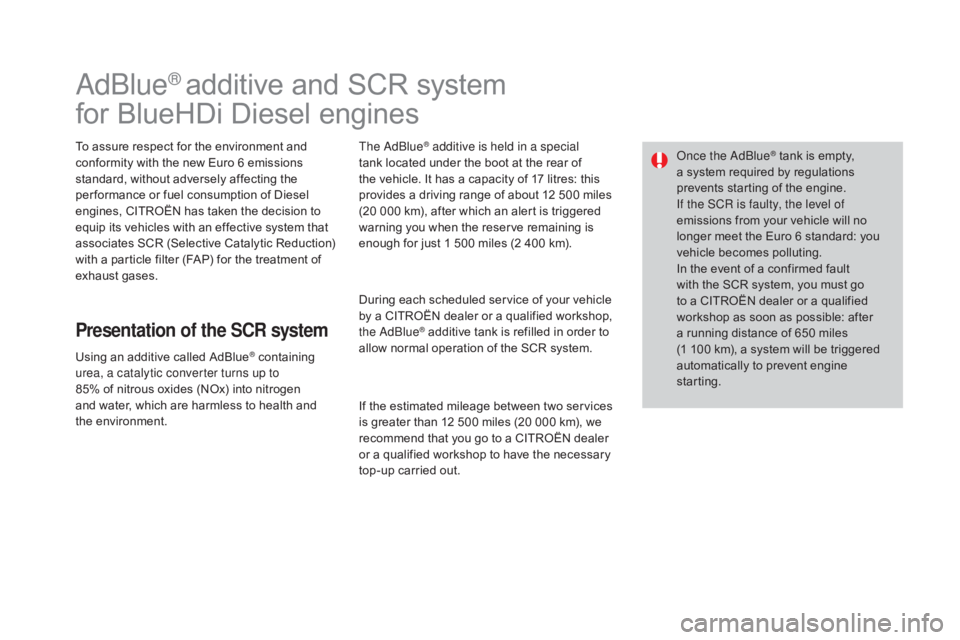
DS3_en_Chap08_info-pratiques_ed01-2015
AdBlue® additive and SCR system
f
or
BlueHDi Diesel engines
To assure respect for the environment and c
onformity with the new Euro 6 emissions
s
tandard, without adversely affecting the
p
er formance or fuel consumption of Diesel
e
ngines, CITROËN has taken the decision to
e
quip its vehicles with an effective system that
a
ssociates SCR (Selective Catalytic Reduction)
w
ith a particle filter (FAP) for the treatment of
e
xhaust gases.
Presentation of the SCR system
Using an additive called AdBlue® containing u
rea, a catalytic converter turns up to
85% of
nitrous
oxides
(NOx)
into
nitrogen
a
nd
water,
which
are
harmless
to health and
t
he environment. The AdBlue
® additive is held in a special
tank
located
under the boot at the rear of
t
he
vehicle.
It has a capacity of 17 litres: this
p
rovides
a
driving range of about 12 500 miles
(
20
000
km),
after which an alert is triggered
w
arning
you
when the reserve remaining is
e
nough
for
just 1 500 miles (2 400 km).
During
each
scheduled service of your vehicle
b
y
a
CITROËN dealer or a qualified workshop,
t
he AdBlue
® additive tank is refilled in order to a
llow
normal operation of the SCR system.
If
the
estimated mileage between two services
i
s
greater
than 12 500 miles (20 000 km), we
r
ecommend
that you go to a CITROËN dealer
o
r
a
qualified workshop to have the necessary
t
op-up
carried out. Once the AdBlue
® tank is empty, a
system
required
by regulations
p
revents
starting
of the engine.
If the SCR
is faulty, the level of
emissions
from
your vehicle will no
l
onger
meet
the
Euro 6 standard: you
v
ehicle
becomes
polluting.
In
the
event
of
a
confirmed fault
w
ith
the
SCR
system, you must go
t
o
a
CITROËN
dealer or a qualified
w
orkshop
as
soon as possible: after
a
running
distance of 650 miles
(
1 100
km),
a
system will be triggered
a
utomatically
to
prevent engine
s
tarting.